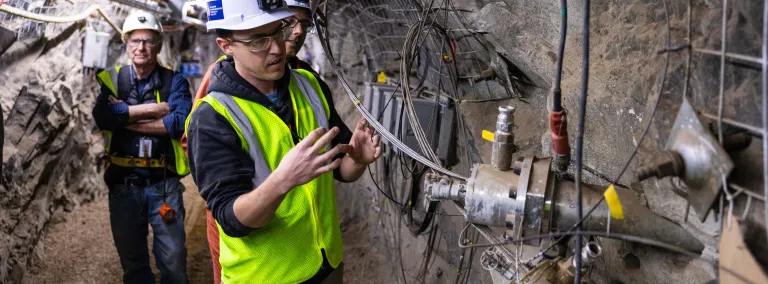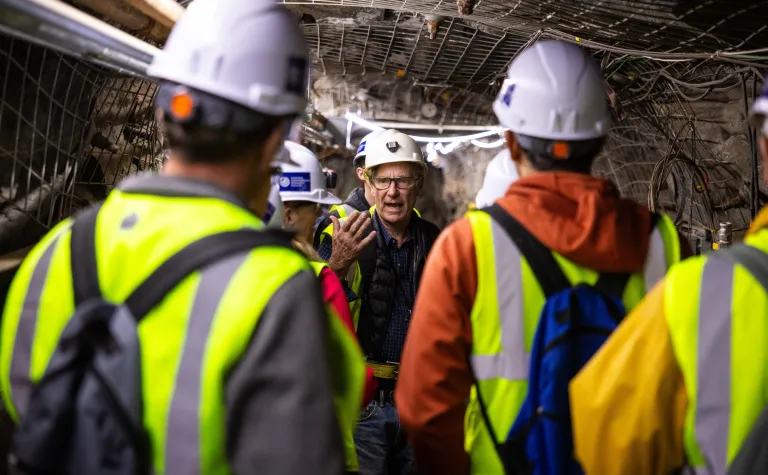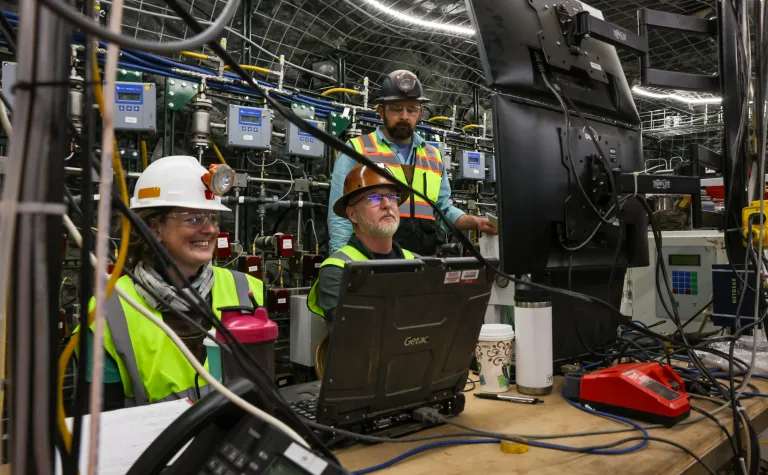Geothermal research at America’s Underground Lab can bolster U.S. energy independence in the digital age
The deepest laboratory in the United States provides a unique test bed for the study of enhanced geothermal systems.
With a total depth of 8000 feet, the Sanford Underground Research Facility (SURF) is a one-of-a-kind location for experiments that are pioneering new ways to harness heat stored deep inside the earth.
SURF has hosted a series of geothermal initiatives over the last decade, the latest is the Center for Understanding Subsurface Signals and Permeability (CUSSP). The multi-institutional project, led by Pacific Northwest National Laboratory (PNNL) and funded by the U.S. Department of Energy (DOE), could revolutionize the production of electricity by allowing the construction of geothermal power plants almost anywhere on the planet.
As the digital age increases the demand for energy, these new Enhanced Geothermal Systems (EGS) have the potential to help meet the nation’s growing need for electricity. In the most basic sense, EGS technology involves cold water pumped into deep wells where it is heated by the Earth and returned to the surface as hot water or steam that will spin a turbine for the creation of electricity.
Enhanced geothermal technology is the next frontier for energy deployment with the potential to power more than 65 million American homes and businesses. The tech sector is leading the way in developing EGS. In late 2023 tech giant Google, in partnership with geothermal startup Fervo Energy, announced the completion of the first enhanced geothermal energy power plant in the country.
Like all fledgling technology, research is required to improve and advance its potential. EGS has challenges to overcome; for example, the underground fractures where heat is transferred to the fluid can become clogged. Over time, the water that is pumped into deep underground fractures can leave behind minerals that slow or stop the flow, in same way the water pipes in an old house can become mineralized and clogged.
“The big unknown is how long these reservoirs will last,” said Kevin Rosso, director of CUSSP. “We are seeing successful EGS pilot projects all around the world right now that prove this technology works. But we don’t know if these underground reservoirs will continue to produce heat effectively at the same rates for decades.”
Rosso is a Battelle fellow and the associate director of the Physical Sciences Division for Geochemistry at PNNL. He says CUSSP aims to ensure that EGS power plants provide a return on investment.
“Whether or not these installations will be economical is still unproven territory at the moment. This is where CUSSP is out in front, working to answer these questions,” Rosso said.
Searching for Signals in the Noise
There are many variables to consider when working to keep enhanced geothermal systems from clogging up over time. The water chemistry, rock types, heat, pressure, and the rates of flow through underground fractures are some of the factors that can vary and change.

Some members of the CUSSP collaboration on board a mine rail cart headed for the geothermal test bed laboratory on the 4100 Level of SURF.
Photo by Stephen Kenny
The geothermal test bed, located on the 4100 level of SURF, is a place where many of these variables can be controlled and understood.
“That's one of the exciting things about this location. Here we have control over water temperature, water chemistry, and we know the rock types, and that's something that's never been done before,” Rosso said.
Another challenge is the chemical reactions that lead to mineralization and clogging of fractures deep inside geothermal systems that normally occur miles underground–where they can’t be seen. This is where remote sensing comes in. At SURF, scientists can employ a wide variety of sensing equipment in the test bed, from water and rock temperature and chemistry measurements to seismometers and electrical resistivity sensors, all of which help researchers better understand what is happening underground.
“We have multiple geophysical sensors collecting terabytes of data in real-time during these flow experiments,” Rosso said. “The experiment allows us to learn what the signals look like that correspond to certain processes we see happening.”
This ability to search for signals in the noise and corollate them with what’s happening underground at SURF allows CUSSP scientists to build a better understanding of the complex processes that govern geothermal systems—and build better models that can be used across multiple geothermal extraction sites.
“Developing the ability to understand the chemistry remotely with geophysical signals is very exciting, and also very challenging,” said Jeff Burghardt, an Earth Scientist at PNNL who is working on parallel geothermal research at SURF. “It's sort of a moonshot idea at this point, but I think we have a plausible path forward to being able to do it, and that would be a game changer.”
A multidisciplinary collaboration that is building the next generation STEM workforce leaders in America
The complexity of these problems requires large teams with a range of skills. CUSSP includes a collaboration of 40 researchers assisted by many undergraduate, graduate, and postdoctoral students. This means geochemists and geophysicists are rubbing shoulders with mechanical engineers and computational scientists, all who are working together to achieve the same goals.
“It's really exciting to see multiple disciplines coming together, rallying around a really focused problem,” said Rosso.
One of the co-principal investigators on CUSSP is Alexis Navarre-Sitchler, a geochemist and professor in the geology and geological engineering department at Colorado School of Mines. Navarre-Sitchler shares Rosso’s excitement.
“This is the science that is taking us into the future,” Navarre-Sitchler said. “This effort to lay the scientific groundwork and to invest in the fundamental research needed to develop geothermal in efficient and responsible ways will ensure longevity of these projects in the future. It’s a very fulfilling project to be involved in.
Rosso notes the mix of leading researchers, postdocs, and students who find this work fulfilling are also those who will continue to push the field of geothermal energy forward in the coming decades.
“You know, CUSSP is an engine for the next generation of leaders who will be calling the shots for enhanced geothermal systems. I'm particularly excited about just seeing the students working on this project, many of them will make their careers here. And at the same time the nation will get a workforce of experts to help lead the country forward in geothermal energy.”
The work at SURF also complements investments at other DOE geothermal facilities like the Frontier Observatory for Research in Geothermal Energy (FORGE) in Utah. SURF is one of 16 deep underground laboratories around the world. Other labs in countries like China, Canada, Russia, Italy, and the United Kingdom are all competing for similar advancements in underground science.


